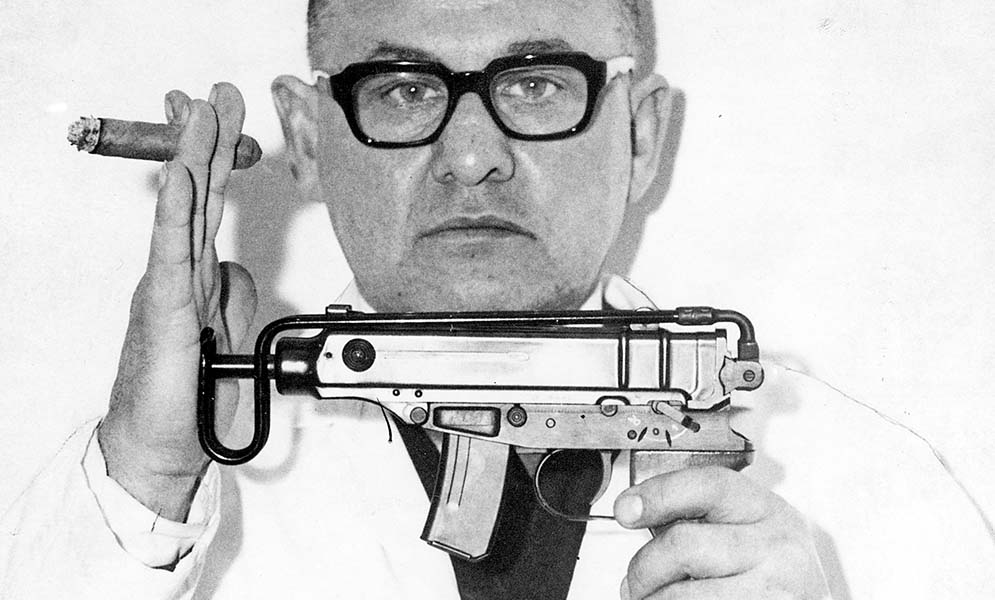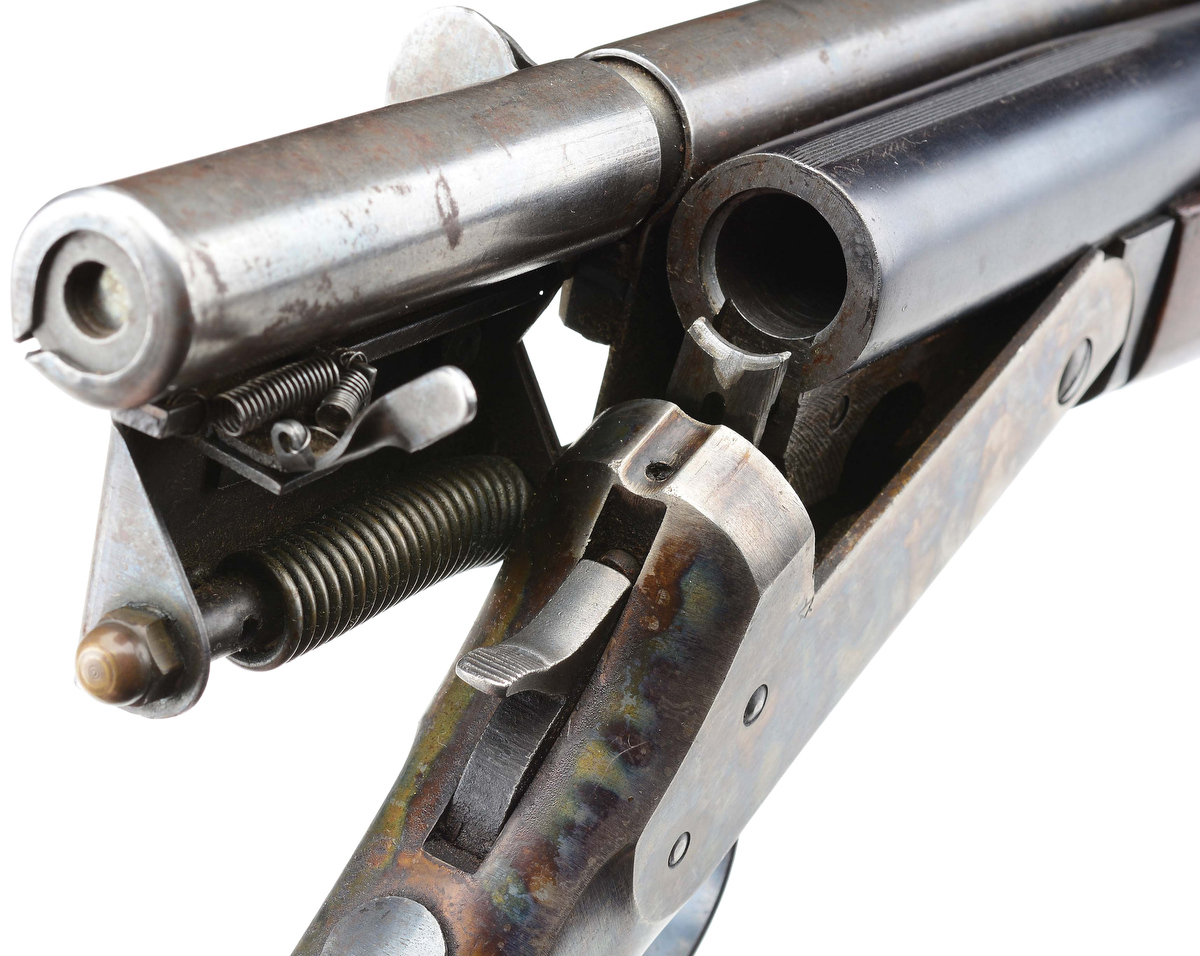By J.M. Ramos
The war in the Balkans has dramatically shown arrays of interesting small arms carried by foot soldiers on both sides. NATO’s infantry, consisting of armies from various countries around the world, are equipped with mixed class of hardware. From the U.S. M-16 to British and French Bullpup assault rifles, the battlefield is decorated with hi-tech weaponry which are likely to stay until the next century. Yugoslavia on the other hand, borrowed much of its small arms technology from the Russians, most notably the Avtomat Kalashnikov weapon system which consisted of combat rifles and light machineguns.
On sub-machinegun development, Belgrade’s arms factory once again copied from previous designs. The army’s M-49 and M-57 are based from the Soviet PPSh-41 submachineguns. There are however differences primarily in construction of components. The Soviet weapon relies heavily on stamping technique, while the Yugoslavian factory constructed their version with machined components and drawn tubings. The barrel jacket has drilled circular holes rather than the stamped elongated slots on the PPSh guns. The push button safety is located in the forestock above and forward of the trigger guard. The safety mechanism on the Soviet gun is built into the cocking handle in the form of a sliding block which when pushed in towards the receiver locks into the cocking handle travel slot whether the bolt is in closed or open position. An interesting buffer assembly was also added in the later M-57. It is comprised of an independent buffer spring and split rings, positioned at the rear of the recoil spring guide. This buffer system was originally used in the Beretta M38A designed by Tullio Marengoni of Italy. The fire selector arrangement are identical on both the Soviet and Yugoslav submachineguns.
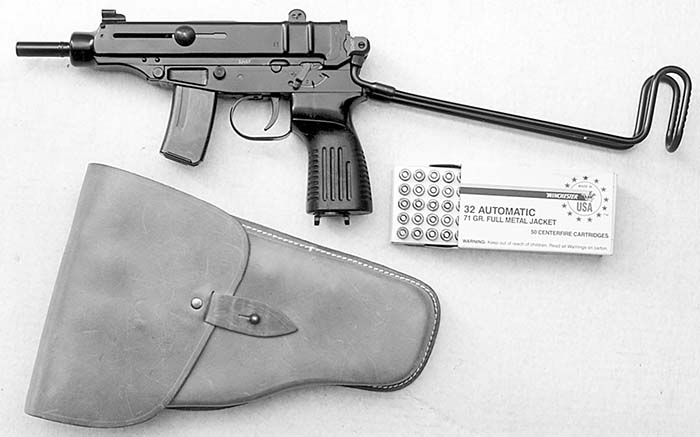
Their second generation M-56 and M-65 submachineguns are direct descendants of the famed WW II German MP-40 with the provision for a bayonet attachment. The M-56 fires the old Soviet 7.62 mm pistol cartridge and has a curved magazine. The M-65 utilized the standard 9mm Para and uses a straight magazine. Both weapons fire from the open bolt and have a selective fire capability. Magazines contained 30 rounds on both models.
In l984, the Yugoslav arms factory of Zavodi Crvena Zastava, expanded their line of small arms production with the addition of the 7,65 mm M-84 machinepistol. In the past, arms factories in Yugoslavia took time to improve battle tested SMG designs of post and WW II patterns. However, their version of Model 84 was a direct copy of the Czech M-61. It was produced under licence from the Czech Ordnance factories which originally manufactured it as the infamous “Skorpion” machinepistol, a weapon of choice among European political assassins. The Skorpion earned its notoriety back in the 70’s and 80’s with the assassinations of many top political leaders and military attaches in France, Italy, Belgium and other part of central and Eastern Europe, many of which became front page news around the world.
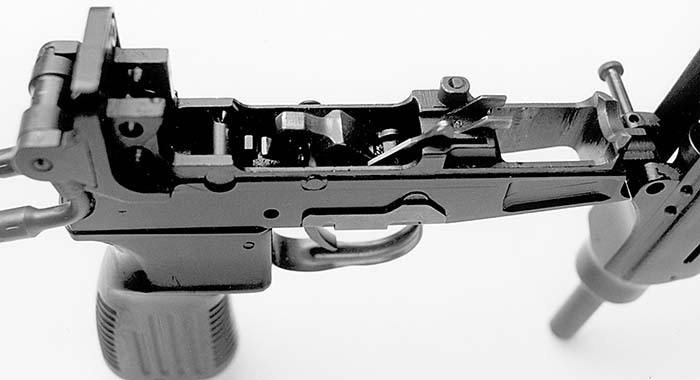
In order to understand what is so special about this unique but very lethal pocket machinegun, we must briefly look at the very interesting developmental background on how the Skorpion machinepistols came into being. In the later part of l950’s, the Omnipol, a state agency who controls Czechoslovak’s arms productions, pushed for rapid development of new generations of small arms to replace their near obsolete post war weapons. The M-52 is the first production pistol to utilize a roller-lock locking system and fires the powerful Russian 7,62mm bottleneck cartridge. This service pistol was superseded by a new class gun which can be employed as a dual purpose weapon. The new gun is neither a pistol or a submachinegun in laymans term. It falls in between having the capability of fully automatic fire but yet small enough to be carried on a hip holster like a service pistol.
Such class of pistol was introduced earlier in the form of the German made Mauser Schnellfeuer of the “Broomhandle” genre and Astra Model 903, basically a Broomhandle clone with internal mechanical variation. Both the German and Spanish selective fire pistols became a favourite among Chinese warlords and were also used extensively by the Chinese army that was in short supply of submachineguns against the Japanese during the early stage of the second world war. The term “machinepistol” as we commonly used today to describe service type handguns capable of full-auto fire can be awarded to Astra and Mauser with their early first generation selective fire Broomhandles. The Czech Vz-6l therefore can be classed as a second generation machinepistol with more modern styling. The exterior format of the Czech gun however is influenced by the Broomhandle with the magazine still positioned infront of the trigger guard.
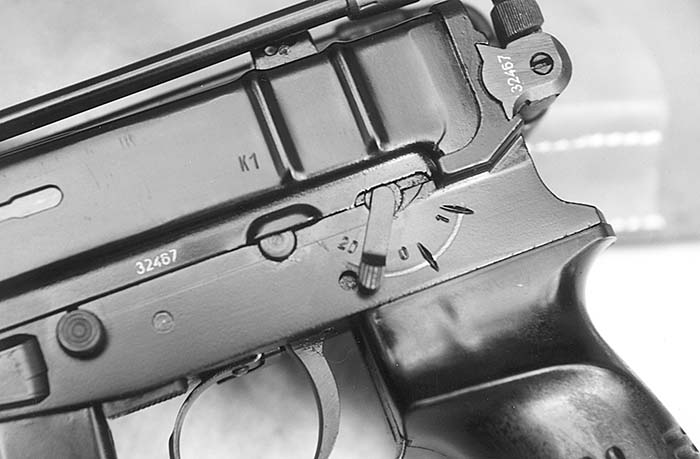
Machinepistols that followed are compact and sleeker service type handguns redesigned to fire fully automatic. The earliest of such class are the l930 Spanish Star machinepistol, a l9ll clone. Colt also experimented with machinepistol prototypes of their famed .45 automatics before and during WW II. In l95l Beretta produced a limited number of their 9mm Brigadier machinepistol and called it the M-951A. This was followed by the more sophisticated M-93R in the later part of the l980’s. The M- 93R is based from the current M-92F service pistol with the addition of a three shot burst, a folding front grip and a detachable folding metal stock. The M-93R is one of the finest modern day machinepistols ever made.
During the Vietnam conflict, a prolific gun designer from Studio City, California named Gordon Ingram created the all stamped M-l0 and M-11 machinepistols which was produced by Military Armament Corporation (MAC) in Marietta, Georgia. The Israeli Military Industries (IMI) also made their own version called the Micro-UZI which is a scaled down version of their legendary UZI submachinegun. The MAC and IMI guns are also produced and marketed in semi-auto versions for civilian market. These guns can be considered oddballs among the machinepistol contenders although short in length, they are wider in general and they utilize double column submachinegun magazines.
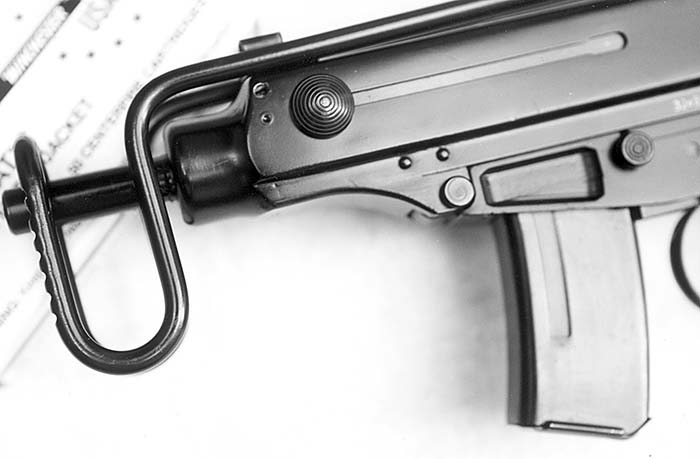
The German firm of Heckler & Koch also develop such a weapon in the form of the VP-70 using futuristic polymer technology for VIP security and police market. This gun is based from their VP-70Z double action striker fire pistol, which met with very limited success. What the VP-70 failed to achieve however was filled up by the later and more sophisticated MP5-K machinepistol. In l995, the Steyr company of Austria joined the race to develop a more advanced machinepistol utilizing space age polymers pioneered by H&K and came out with what they called “Tactical Machine Pistol” (TMP) chambered for the 9mm Para. A civilian version of the TMP was also offered and was designated SSP. Both weapons are externally identical except for the additional forward pistol grip on the full auto model. A new polymer machinepistol contender from Austria was introduce in the Police market not too long ago. This was the highly secretive Glock-18, a selective fire derivative of the very popular Glock pistol series capable of semi or three-shot bust auto fire via slide mounted fire selector.
The soviets also have their own version called the APS machinepistol designed by Igor Yakovlevich Stechkin. The “Automatic Pistol Stechkin” (APS) has a 20-round double stack magazine and a detachable shoulder stock which also doubles as a holster. There are many more experimental machinepistols, SMG’s and ultra-compact assault rifles and underwater guns developed by the Russians in the last 40 years. Lately, more of these highly secretive weapons are starting to be known in the west with more classified informations being leaked by defectors and black market traders who smuggle them out for profits.
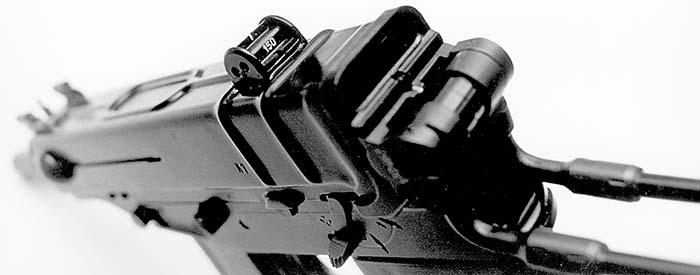
After briefly going through the various models that fall under the category of the machinepistol class that were produced or introduced since the early part of the century to its present status, we can now proceed to cover the deadly Czech and Yugoslavian Skorpion machinepistol family. In addition to being used by the Czech military, the Vz-61 as originally designated, was mainly manufactured for the export market. The weapon was first produced in 7,65mm (.32 ACP) followed by the Vz- 63 in .380 ACP, Vz-64 in 9mm Makarov and the Vz-68 in 9mm Parabellum. The Vz-68 utilized a straight type box magazine while other versions used the more common curved patterns. In the early part of l997, the firm of Ceska Zbrojovka (CZ) started advertising three new models based from the original Skorpion series including a semi-auto variant called the CZ-91S. This pistol was offered in caliber .32 ACP (10 & 20-shot mag), .380 ACP (12, 24 & 30 -shot mags) and 9mm Makarov (12, 24 & 30-shot mags). The new machinepistol designations are Model 83 Skorpion (.380 ACP) and the original Model 61 Skorpion (.32 ACP). The M-83 utilized 12, 24 and 30-shot straight magazines while the M-61 uses the older 10 and 20-shot curved magazines. Interestingly, in addition to producing the new Skorpion series, CZ also now market a new machinepistol based from their very popular CZ-75/85 combat pistol in caliber 9mm Para. The regular thumb safety had a three-position index, SAFE (uppermost), SEMI (middle) and FULL (downward) positions. A special catch was added in the front section of the receiver in front of the trigger guard to snap a spare loaded/unloaded magazine into place to function as a front grip for maximum control when firing the gun in fully automatic mode.
Although the gun covered in this write-up is the Yugoslavian M-84, I am also quite fortunate to having examined and tested the original Czech Vz-61 back in l979 for comparison. The Vz-61 was designed by Miroslav Ribarzh. It utilizes l0 and 20-shot curved magazines. The gun also came equipped with a tan coloured cowhide belt holster and a separate dual magazine pouch made of the same material and stitching. Mag pouches are available for both the 10 and 20-shot magazines in dual format. A shoulder holster, reminiscent of the old G.I. fighter pilot l9ll pistol shoulder holster was also made for the Skorpion and was issued to tank commanders. In addition, a simple but rather large suppressor was also developed for the Vz-61 for clandestine operation. An experimental detachable wooden stock was also tested for the Vz-68 9mm Para version but was not produced commercially.
In comparing the older Vz-61 and newer M-84 made under licence after having examined and test fired both in twenty year time interval, I found no differences in mechanical and external design with the exception of the plastic grip color and decorative grooves. The older models can be found with either wood or light brown plastic grip with four vertical grooves of equal lengths. Both the back and front of the grip also featured vertical grooves of the same size and length. The Yugoslavian M-84 version as well as the newly introduced Skorpions by CZ featured similar grip design using black plastic grips. The original four vertical grooves of equal length at the sides of the grip is being retained except that the last groove at the rear is now shorter. The older vertical grooves at the front and back of the grip is now being replaced by horizontal groove patterns for better gripping provision. CZ offers a wooden grip with the old style vertical grooves in the grip as an option for collectors.

The M-84 being an exact clone of the original Vz-61 Skorpion have many interesting mechanical features. It utilizes a wrap-around bolt similar to that of the UZI SMG pattern. Although the UZI popularized the use of the wrap-around type bolt in SMG design, it was the Czechs who pioneered it. The bolt system was first used by the Czechs in their ZK-476 SMG designed by the Koucky brothers working at the Brno factory in the later part of WW II. The light bolt mass on the Skorpion operating on a straight blow-back short-recoil generates excessive rate of fire on full auto which required the addition of a spring loaded cyclic rate reducer. The reducer temporarily hooks the bolt to the rear during each cycle thereby keeping the cyclic rate down to approximately 840 r.p.m. Without the reducer the weapon will easily fire in excess of l000 r.p.m. in full auto.
The bolt is powered by twin recoil spring arrangement positioned on both sides at the top. A unique dual side-by-side cocking knobs with circular grooves locks in to the front end section of the bolt. The ejection slot was cut at the top of the bolt. A matching slot is also stamped at the top of the bolt cover. When the bolt is closed, its rear end section (solid part) lines up with the ejection slot of the bolt cover thereby preventing dirt entry. An automatic hold-open device was incorporated thereby holding the bolt open after the last round has been fired. To release the opened bolt, simply pull the cocking knobs to the rear as far as it will go to then release to recoil forward after a fresh loaded magazine is inserted to the gun. If the weapon is not to be fired, remove the empty magazine and pull back the knobs and release forward. A push button magazine catch was incorporated and is located on the left side of the receiver.
The gun operates from a close-bolt utilizing a pivoting hammer. During full auto fire, the hammer is held and release by an automatic sear, which is actuated by the bolt cam as it reaches its full forward stroke. The trigger mechanisms have inherited some features from the AKM, however use a compression type spring to power the hammer rather than the usual multi-strand coiled wire in the AK tradition. The trigger pull is light (approx. 4 lbs.) consistent and crisp. The fire selector is positioned to the left side of the receiver where it is easily accessible by the thumb of a right handed shooter. It features three-position indexes. Rear (1) semi-auto, middle (0) Safe and forward (20) full auto. The Skorpion is a true machinepistol in all respect. It can be easily fired from one hand with the wire stock folded. For more precise shooting, the stock can be unfolded and used as a shoulder rest. The length of the stock is somewhat short and shooting with it is a bit uncomfortable. The wire stock is of very good arrangement however somewhat undersized at the butt and length and a bit wide for comfort. The locking index is solid and simple to operate. To unfold the stock, simply rotate until it stops. This will automatically lock the stock in the extended position. To fold the stock back to the top of the gun, press the left side base until the lock is clear then rotate upward till the movement stops and locks into place.
Shooting the both the Czech Vz-61 and the Yugoslav version M-84 is a pure delight. Recoil with the .32 ACP is almost non existent. It shoots and feels like a .22 cal. pistol. Accuracy at 25 yards is very good both in semi and full auto averaging 3-4 inch spread using Winchester ammo. Unfortunately, I was only able to shoot this brand of ammo during the test of the M-84 because most of the gun stores I visited no longer carry the .32 ACP. However, I did fire over 500 rounds of mixed brands with the original Vz-61 in l979 and found the weapon to be extremely accurate well beyond its 75 meter setting using the wire stock and resting the muzzle on a tree branch, shooting milk jugs filled with water.
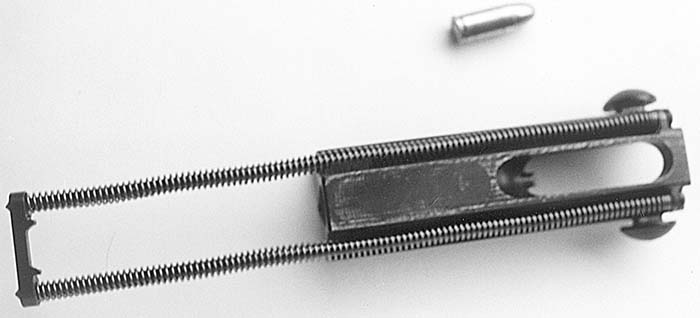
Field stripping of the M-84 for cleaning is identical to the Czech Vz-61. The procedure is extremely simple, fast and requires no tool. Clear the weapon and remove the magazine. The procedure starts by first making sure that the wire stock is on the extended position to allow forward movement of the upper receiver. Next, move the selector to the fire position (semi or full auto setting). Pull the takedown pin head located on the left side forward of the magazine well out to the left as far as it will go. Now pull the upper receiver forward by about 3/l6 inch then swing the muzzle down to open the action. Retract the bolt fully to the rear and pull the cocking knobs out to the sides after the knobs lined up with the enlarged section at the end of the long slots. Pulling the recoil spring base at the rear will also raise the bolt out of the opened action. No further disassembly is required for routine cleaning after firing the weapon. The base of the grip is in the form of a vertical cylinder which doubles as an oil container. A spare recoil spring can also be looped in the tubing cap dipper and stored inside the cylinder.
The overall workmanship of the M-84 is superb, definitely comparable to the original. There were no manufacturing shortcuts noted. Except for the stamped bolt cover and moulded plastic grip, the majority of the components are beautifully machined and finished. While many may consider the Vz-61/ M-84 family of machinepistols obsolete by today’s standard, make no mistake about it, these Skorpions of the Balkans are as deadly as any stingers could be.
| This article first appeared in Small Arms Review V3N2 (November 1999) |



